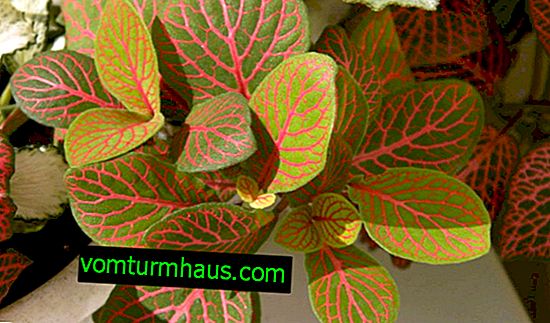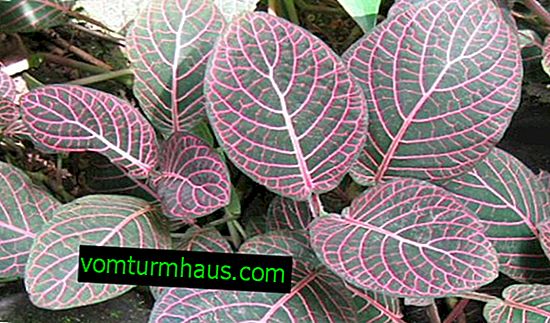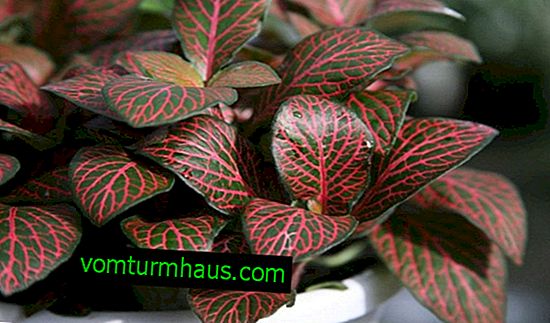How to care for fittonia at home
Fittonia belongs to the list of indoor plants, the main advantage of which is called leaves. This guest from the South American forests has an attractive mesh color of leaf plates, which attracts the eye against the background of other colors. However, not every grower undertakes to grow Fittonia bushes, because this is a very demanding plant with its own peculiarities in care. It is the nuances of flower care that this article will be devoted to.
Botanical description of the plant
Indoor flower Fittonia is a herbaceous perennial from the Acanthus family. It was first discovered in the jungle of Peru in the 19th century, then the name in honor of the botanists of the Fitton sisters from Britain was fixed.
In nature, you can find various variations of Fittonia, however, the following symptoms are characteristic of all indoor species:
- superficial root system with shoots actively branching to the sides, thanks to which the flower easily roots in new places;
- low creeping stems (up to 10 cm), decorated with a silver fluff in young specimens and greening over time. In their nodes, roots are easily tied up in contact with the ground;
- leaves in the form of an ellipse (no longer than 6-10 cm) with a mesh pattern of veins of white or pink shade on a dark green background.

Important! The plant does not have a clearly defined flowering or dormant period.
In the presence of comfortable conditions on curly shoots, small, inconspicuous spikelets-flowers with large bracts appear in the lower part. They are painted in cream or light shades, so most often merge with the leaves.
The main types
In the natural habitat of the varieties of the flower are many, among them there are even upright. Among them, only two species (Vershaffelt and silver-veined) were able to live at home.
It is on the basis of these specimens that breeders have bred a number of hybrids, among which the most popular are:
- "Skeleton" . This fittonia is distinguished by velvety leaves with a bright olive color and a fine mesh of red veins;

- Perseus . So called one of the smallest decorative varieties of plants, glossy leaves which shimmer with sparkling raspberry mesh;

- King Cross . The main feature of this unusual subspecies is the light color of the plant and the corrugated edges of its leaves, due to which the foam effect appears;

- "Franks . " In the color of this Fittonia there is a mixture of green and pink colors, darkening closer to the curly edge of the leaf;

- "The red angel . " The name reflects the appearance of the flower: it shimmers with all shades of red, and only the edging on the leaf has a dark green tint.

Conditions for successful growing at home
Fittonia as an indoor plant often becomes a component of various florariums and flower arrangements. Its decorative leaves will decorate any home, but it is important to first make sure that you can provide the necessary environment for a tropical plant. Otherwise, all his beauty will quickly go down.
Important! Hybrid varieties of Fittonia do not bloom, their main decoration is an unusual color of leaves.
Location and Lighting
A flower loves diffused light, so try to provide it with a suitable place. He will feel great on the southeast or south side. In winter, Fittonia will be comfortable right on the windowsill, but in summer it is advisable to rearrange the plant in light partial shade, where its leaves are not threatened by burns from direct sunlight.
Temperature and humidity
The creation of a comfortable environment for the flower is facilitated by:
- optimal temperature for fittonia in the range + 22 ... + 24 ° С, regardless of the season. If there is no way to maintain balance, then in winter, do not let the temperature drop below +18 ° C: prolonged cooling can destroy the plant;
- high humidity. Like a flower with tropical roots, Fittonia calmly tolerates heat, but not dry air. In winter, it is strictly contraindicated for her to be near batteries or other sources of heat, otherwise the plant will lose its colorful appearance. Regular spraying of the plant with settled water at room temperature will help to increase the humidity in the room. In winter, one procedure per day is enough, in the summer 2-3 will be needed. It will also be useful to place a container of water near the phytonia (an ordinary glass of water, an indoor fountain, a pallet with wet stones, etc.);
- periodic airing. Fresh air has a positive effect on the plant, but drafts should not be allowed.

Home Care
It’s easy to care for a flower if you know the features of this process and carefully follow the recommendations.
Did you know? According to popular signs, Fitton attracts wealth to the house.
Watering
Humidification of the soil is carried out as soon as the topsoil dries. Just do not allow drying to an average level, Fittonia does not tolerate this condition well. And the complete drying of the earth in the pot, even for a short period of time, will be the answer to the question of why the wickedness withers.
But the plant should not be poured, otherwise rot will quickly form on its shoots. Be sure to drain the liquid draining into the sump.
In summer, the flower is watered several times a week, in winter, they either reduce the number of waterings, or (which is more effective) their volume, following the rule: it is better to water more often, but with less water.
It is great if it is possible to nourish the plant with rain or melt water. In their absence, ordinary tap water is also suitable, if you let it stand for several days and warm to room temperature.
For watering Fittonia, it is more convenient to use a watering can with a long spout, which allows you to freely irrigate under the root, without damaging the numerous branching shoots.
Top dressing
From the beginning of spring to mid-autumn, regular fertilizers do not interfere with the flower. They are made every 2 weeks. In winter, you can also do top dressing, reducing their dosage by 2 times, and the frequency - up to 1 time per month.

Did you know? The plant horoscope recommends growing Fittonia to people born under the sign of Aquarius. She will help them unleash their creative potential and improve their energy background.
As an alternative, conventional fertilizers for decorative leafy plants can also be used. But its effectiveness will be slightly lower.
Pruning
If you want to get a beautiful plant, you can not do without pruning a bush. It is best to start crown formation in young specimens. Do this by plucking the tops of the shoots. Without such treatment, after 2-3 years of active growth, the flower will grow, and its shoots at the base will be exposed, violating the decorative bush.
When the situation is so neglected, a complete reconstruction of the crown is necessary. To do this, the shoots are cut almost completely, not reaching 5-7 cm to the base of the outlet.
Transfer
Fittonia is transplanted in the spring when the previous pot becomes too small for the plant.
A new one is chosen, taking into account the features of the root system of this perennial:
- the flowerpot should not be deep;
- but at the same time a wide capacity is needed;
- the presence of a drainage hole is mandatory.

Important! When the height of the pot exceeds its diameter, the drainage level is increased, otherwise stagnation of moisture in the tank is possible.
As a soil for fittonia, you can use:
- universal substrate for indoor plants;
- a mixture of turf, sand and peat (2: 1: 2);
- harvesting of peat, deciduous land, turf in equal proportions with the addition of half a portion of sand and a handful of sphagnum.
The transplant itself is carried out by the standard method. The plant is taken out of the pot and, having cleaned the roots of the old soil, is transferred to a new container, sprinkled with fresh soil.
Breeding
If there are difficulties in caring for Fittonia, then propagating the plant is simple. To do this, you can use any of the methods below.
Dividing the bush
During transplantation of an adult mother plant, their powerful root systems can be divided into 2, or even more (depending on the size of the outlet) “children”. The roots are separated easily, it is enough to untangle them carefully. And then you can plant in different pots.
Cuttings
If dividing by a bush is possible only in spring, during the transplant period, then cuttings can be obtained at any time.

- Choose shoots no shorter than 5–8 cm with 3-5 leaves and carefully cut with an oblique cut.
- The resulting stalk is dipped in sand, water or soil to a depth of not more than 1 cm for rooting.
- Then the container with the future seedling is covered with a film or a regular bag to create the effect of a greenhouse (a temperature of at least +25 ° C is required).
- Ventilate the stalk periodically.
Did you know? Feng Shui experts say that the shape of the leaves of Fittonia indicates the concentration of yin energy in the flower, due to which the plant helps to create a friendly, calm atmosphere.
Rooting usually takes up to 1 month, after which the young plant can be transplanted into a pot.
Layering
Flower shoots take root very quickly, which is used by those who want to propagate the plant.
To do this, a young twig from the mother bush is spudded in a pot next door, sprinkling with soil the contact point. Periodically it is necessary to water it, and then new roots will quickly appear. After this, you can separate the shoot from the main plant.
Growing difficulties
If Fittonia does not receive proper care, it becomes noticeable in its appearance and condition:
- the ends of the leaves dry. This is a sign of overdried air, so it is necessary to remove the affected areas and increase the number of sprayings;
- fade stems and leaves. This happens with a lack of moisture, monitor the frequency of watering and do not allow the soil to dry out;
- the internodes on the plant lengthen and the leaves become smaller. So the flower reacts to a lack of light, so try to find another place for it;
- fade the base of the stems. These are the first signs of incipient rot, provoked by excess moisture. Temporarily suspend watering and dry the soil thoroughly;
- the color of the leaves pales. In this case, you need to move the plant, because the sun burns it too much.

- scale shield . These small insects can be found under the leaves, in cuttings, where they feed on plant juices. Their activity provokes the wilting of the shoots, and after that the death of the whole bush. Rinse leaves and stems with rinsing leaves and stems with soapy water or spraying with Fitoverm;
- ticks . Visually detecting these pests is difficult because of their small size, usually their presence is indicated by leaves that suddenly begin to dry, turn yellow. To destroy ticks, the Derris insecticide will help;
- thrips . They, like the scabbard, can be found on leaves, stems. They can quickly destroy the plant, so treatment should be started when the first signs are detected (sluggish leaves, small insects on the inside). They fight thrips with the help of the drug "Fufan".
Did you know? It is useful to put Fittonia in the room of a schoolchild or student: its positive aura promotes creativity and the assimilation of new knowledge.
Fittonia is a beautiful evergreen plant that can decorate any room. Its decorative properties will please even the most demanding grower, but you will have to try to make the flower reach its full potential. The collected recommendations will help even a novice to cope with this task, the main thing is to follow them steadily.








